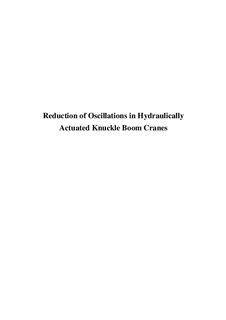| dc.contributor.author | Sørensen, Jesper Kirk | |
| dc.date.accessioned | 2016-11-15T08:41:01Z | |
| dc.date.available | 2016-11-15T08:41:01Z | |
| dc.date.issued | 2016 | |
| dc.identifier.isbn | 978-82-7117-840-6 | |
| dc.identifier.issn | 1504-9272 | |
| dc.identifier.uri | http://hdl.handle.net/11250/2420928 | |
| dc.description | Doktorgradsavhandling ved Universitetet i Agder, Institutt for ingeniørvitenskap, 2016 | nb_NO |
| dc.description.abstract | A knuckle boom crane is characterized by being a versatile machine that during operation experiences large load variations caused by the changes in position and payload. Common uses are as a mobile loader crane mounted on trucks and in offshore applications. Since their introduction the use of counterbalance valves (CBV) have been the de facto standard on load-carrying hydraulically actuated applications like the knuckle boom crane. It offers a simple and practical solution to one of the issues of mobile cranes: Controlling the load safely when lowering. By law (e.g. European Standard) the hydraulic circuit of load-carrying applications is required to contain a load holding protection device. The classical way of actuating such a crane is to use a circuit containing a pressure compensator valve and a directional control valve (DCV) in series with a CBV. This circuit is referred to as the base circuit. It is well known that this combination of valve components tends to introduce instability in the base circuit. This is mainly a problem when the controlled actuator is subjected to a negative load, because this will require the CBV to throttle the return flow. The instability presents itself as pressure oscillations in the hydraulic circuit which cause the mechanical structure to oscillate. The consequence of the oscillations is a decreased accuracy of the boom motion which create a safety risk, reduces productivity and introduces an undesirable extra fatigue load. The objective of this project was to investigate the oscillations created in the hydraulic circuit of knuckle boom cranes and reduce their severity. The effort has mainly been split in two: First, was looked into existing solutions with the focus on the ones not requiring control systems to function. This was done with reliability and robustness in mind. The investigation identified the pressure control valve (PCV) as the best commercially available solution. The use of a PCV to control the inlet flow in crane applications was rather uncharted territory. The valve, a DCV with a pressure control spool manufactured by Danfoss, has been investigated both theoretically and experimentally. A linear stability analysis has been performed with the Routh-Hurwitz stability criterion. This analysis of the valve used together with a hydraulically actuated experimental setup indicates that the combination is stable in all situations. The use of the pressure control spool in the DCV is a simple and robust solution to the stability problem of the base circuit. Not related to the PCV’s ability to reduce the oscillations the use of it in knuckle boom cranes, however, comes with certain drawbacks. The drawbacks include a load dependent dead band and a load dependent inlet flow. In order to achieve similar behavior as the normal pressure compensated DCV a closed loop control system is required. These issues are addressed in this project, where control schemes are proposed to handle them. In the second part the perspective of the search was broadened to include solutions using control systems. This has lead to the development of a novel, patent pending, concept that significantly reduces the oscillations of the base circuit. It introduces a secondary circuit where a low-pass filtered value of the load pressure is generated and fed back to the compensator of the flow supply valve. The work has demonstrated a significant improvement of stability obtained for a system with the novel concept implemented both theoretically and experimentally. The stability has been investigated both using a linear and a nonlinear model of a hydraulically actuated experimental setup. The presented novel concept circuit has the same steady state characteristics as the base circuit but without the corresponding oscillatory nature. Because the main spool of the DCV is not used for stabilising the system, the novel concept can be combined with any feedback control strategy. In this project, the novel concept is presented with linear actuators only. However,its use covers circuits with rotational actuators and CBV’s as well. The base circuit is used as a reference for comparison. Therefore, the stability of the base circuit is also investigated with a linear model. | nb_NO |
| dc.language.iso | eng | nb_NO |
| dc.publisher | Universitet i Agder / University of Agder | nb_NO |
| dc.relation.ispartofseries | Doctoral dissertations at University of Agder; | |
| dc.rights | Navngivelse-Ikkekommersiell-DelPåSammeVilkår 3.0 Norge | * |
| dc.rights.uri | http://creativecommons.org/licenses/by-nc-sa/3.0/no/ | * |
| dc.title | Reduction of Oscillations in Hydraulically Actuated Knuckle Boom Cranes | nb_NO |
| dc.type | Doctoral thesis | nb_NO |
| dc.subject.nsi | VDP::Technology: 500 | nb_NO |
| dc.source.volume | 146 | nb_NO |

